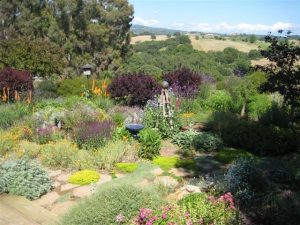Say what? WUCOLS? What the……? W.U.C.O.L.S. (pronounced woo-kuls), which stands for the “Water Use Coefficient of Landscape Plants” was developed by University of California Cooperative Extension to provide basic water-use information about a whole host of plants that you may have in your landscape.
The original document, which was allowed to go out of print, was developed in the 1990’s and was listed as a “Guide to Estimating Irrigation Water Needs.” In the first edition, published in 1992, funded by the California Department of Water Resources, chapter one was devoted to estimating water needs in crops and landscape turf.
Chapter 2 provided general information about evapotranspiration (ET)—a measure of how rapidly a plant uses water—and the landscape coefficient (K)—which takes into account the needs of plant species and the microclimates in which they grow. Additional chapters provided background information on efficient irrigation, calculations, trees in landscapes and other special situations. A model calculation worksheet was included.
In a “Sustainable Backyard: Low Water Use Landscaping” presentation to the Santa Clara Valley Water District in September, 2014, The California Center for Urban Horticulture in the UC Davis College of Agricultural and Environmental Sciences makes the following points regarding WUCOLS:
- It is a “guide” to plant water needs, NOT a method for estimating water use.
- WUCOLS plant evaluations were made by horticultural professionals representing six different climate regions throughout California. (The climate regions are: North Central Coastal; Central Valley; South Coastal; South Inland Valley; High and Intermediate Desert; and Low Desert.)
- Plant water use designations are based on collective field experience and observation.
- Plants evaluations were made by consensus of the evaluators.
- The most current list has been reviewed and updated to 3,769 taxa. Less than 2% of the plants have been scientifically studied in controlled test plots.
- The plant evaluations serve as an important guide for selecting plants for specific hydrozones and can be used by professionals, academics, water agencies, municipalities AND GARDENERS!
- It is not perfect; it is based on “horticultural experience and wisdom,” and is a bridge to scientific study. However, the Department of Water Resources requires that public landscapes complying with the 2009 Model Water Efficiency Landscape Ordinance choose their landscape plants based on WUCOLS’ recommendations.
So, what does WUCOLS mean to you as a home gardener or landscape service provider? There’s a very cool website at: http://www.waterwonk.us/ that allows you to input your city and the website then tells you in which of the six regions you belong. You can then develop a plant list based on various criteria. As an example, I typed in Sonora and clicked on the box next to “groundcovers.” I asked for low-water use plants and California natives. The website returned a list of 41 plants that, from field experience and observation, would satisfy those planting needs.
University of California Agriculture and Natural Resources also hosts a webpage, http://ucanr.edu/sites/WUCOLS/, full of information. It contains a user manual, a plant list and a search engine. For example, you can click on each region and see a list of cities included in that region. You can then click your city of interest. Both Angels Camp and Sonora are included in the “Central Valley” region. An all-inclusive plant list will also advise whether a plant is “inappropriate” for your particular region.
As we enter this next year of extreme drought, the use of potable water to sustain our lush landscapes becomes increasingly inexcusable. WUCOLS provides another updated and engaging tool to help us control our outdoor water usage.
Rebecca Miller-Cripps has recently retired from employment with University of California Cooperative Extension, is Master Gardener of Tuolumne County and is making a hobby of converting her Jamestown home landscaping to low-water use California natives.


